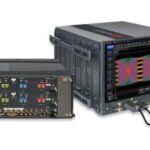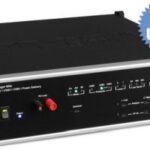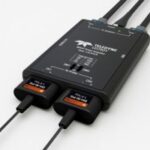A new firmware option has been created by Spectrum Instrumentation that allows the company’s high-speed M5i.33xx series of PCIe high-speed digitizers cards to perform on-board summation averaging. Averaging is a useful tool for reducing unwanted signal noise, while at the same time improving measurement resolution, dynamic range and signal-to-noise ratio (SNR). The new option enables […]
Analyzer
BERT supports PCI Express 6.0 base specification receiver test
The Signal Quality Analyzer-R MP1900A now supports the PCI Express 6.0 (PCIe 6.0) Base Specification Receiver Test (Rx Test) and has been further enhanced with an SKP function to filter SKP packets to support separate clock architecture (SRNS). As a result, one MP1900A supports PCIe 3.0 to PCIe 6.0 and can calibrate stressed test signals […]
BERT Ethernet test gear handles 224 Gbps signals
New 224G Ethernet test solutions enable system-on-a-chip (SoC) makers to validate next generation electrical interface technology, accelerating 1.6 terabit per second (1.6T) transceiver design and pathfinding. 5G, artificial intelligence (AI) and internet of things (IoT) applications are driving growth in data traffic, creating unprecedented bandwidth demands in networks and data centers. High-speed digital interfaces that […]
Single-sweep VNA-spectrum analyzer spans 70 kHz to 220 GHz
The VectorStar vector network analyzer (VNA) family now inclues the world’s first single sweep VNA-spectrum analyzer solution that supports 70 kHz to 220 GHz. With the spectrum analyzer option installed, VectorStar can conduct single connection VNA and spectrum-based measurements to create a more efficient and accurate testing environment to verify active and passive devices during […]
PCI Express 5.0 interposer works with protocol analyzers
A PCI Express 5.0 Mini Cool Edge IO (MCIO) interposer works in combination with Teledyne LeCroy’s Summit family of PCI Express 5.0 protocol analyzers. The new interposer enables engineers to test products that incorporate card edge connectors or cabled connector assemblies that utilize the MCIO mechanical connector with PCIe 5.0, NVM Express (NVMe) or Compute […]
Vector signal analysis software delivers post processing measurements, analysis of IQ data files
The IQ Signal Master MX280005A Vector Signal Analysis software delivers expanded post processing measurements and analysis of IQ data files captured on Anritsu Field Master Pro MS2090A, Remote Spectrum Monitor MS27201A, and Remote Spectrum Monitor MS2710xA spectrum analyzers. Designed for challenging field environments, the software assists government regulators inspect the RF spectrum, security agencies track […]
Network installation and maintenance test tool adds 400G module
A 400G module for the OneAdvisor 800 network installation tool provides advanced 400G transport test and maintenance functionality for business service and network core technicians working in the field. Combining its transmission protocol and fiber network modularity, the OneAdvisor 800 offers unprecedented testing performance for technicians who must carry their gear into the field. Building […]
What’s all this VNA calibration stuff?
In general, the electrical characteristics of circuits associated with high-frequency instruments vary significantly with time. Signal sources, receivers, and interconnections drift with vibrations, cable flexing, temperature, humidity, and so forth. That’s why vector network analyzers (VNAs) are only treated as being time-invariant over short time periods (a few hours). Thus a VNA must be calibrated […]
Analyzer performs USB4 compliance tests
A USB4 compliance test option for the Voyager M4x analyzer and exerciser system can be used in conjunction with the USB Implementers Forum’s (USB-IF’s) USB4 Command Verifier (USB4-CV) software to generate traffic conditions and verify responses for the official USB4 logical, protocol, and tunneling layer compliance test specifications. USB4 combines the simplicity of the USB […]
MIPI M-PHY High-Speed GEAR 5 UFS 4.0 protocol analyzer/exerciser sports solder-in probes
The Eclipse M52 Analyzer/Exerciser supports the next generation of M-PHY High Speed Gear 5 (HS-G5), UniPro 2.0/UFS 4.0 development and can be configured now with the new GEAR 5 solder-in probes. The Eclipse M52 analyzer/exerciser assists design and test engineers working with the high data rates and aggressive power management of the UniPro and UFS […]










